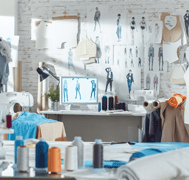 Technology has enabled some amazing feats in the world of fashion.
Technology has enabled some amazing feats in the world of fashion.
Take Adidas Parley as an example. These shoes are literally made from plastic trash recovered from the ocean!
In addition to ground-breaking products, technology is helping fashion businesses make both big and small improvements every day.
… and what’s driving these enhancements?
Data. Today more than ever, data is helping companies in the fashion industry understand the market trends and create tailored products quickly and more cost-effectively.
Here’s how data is taking fashion brands forward.
Managing the Product Lifecycle
In today’s era of customization and fast-changing fashion scene, fashion businesses are working with extraordinarily complex matrices and constantly releasing new collections and designs. There are not just multiple products but each product usually has multiple sizes, colours, and styles/fits.
Product lifecycle management software can help in developing, manufacturing, and taking these products to the market by leveraging valuable data.
This data includes insights from the market, inputs from different departments, customer feedback, and more. Once data comes together in one platform, it has the potential to guide the product ideation process, simplify procurement, and reduce the time-to-market.
Improving Customer Experience and Offering Transparency
As shoppers move online to make their purchases, the human touch is lost because these individuals are no longer interacting with sales representatives in-stores.
This means that there is added pressure on the e-commerce and digital platforms, of the brand, to attract customers and nudge them to get past the check-out point.
This is where customer experience becomes extremely important.
Data can help brands understand the preferences of their customers and offer insights into their favourite items and clothing lines. Equipped with this information, brands can offer attractive promotions and discounts on the things their customers love.
Additionally, data analytics can help show the customers’ reviews as well as the ‘right’ recommended or related products. Dynamics 365 Commerce, for instance, helps brands deliver personalized, appealing web experiences and targeted sales promotions across all channels.
Another key area where data can help is giving customers visibility into delivery timelines and re-stocking dates. This is particularly relevant today, due to COVID-19 induced supply chain delays. This helps customers be more aware and set realistic expectations.
Having a Single Repository of Information
Data can’t help your business until it’s easy to access, can be shared around, and analyzed.
Having a solution that acts as a single repository of information helps! When different strands of data are pulled into one single location, more meaningful analysis can be performed and cross-departmental benefits can be gained.
Microsoft Dynamics 365 Business Central, for instance, is a fully integrated solution that helps fashion brands leverage data to support business processes ranging from planning and sourcing to warehousing and financial administration.
Supply Chain Resilience
Research from McKinsey shows that the value of excess inventory from spring/summer 2020 collections, of brands, was estimated at €140-160 billion worldwide! This number is more than double the normal levels for the sector.
As COVID-19 continues to negatively impact supply chains, reliance on data can support in tackling these issues. By obtaining timely data and coupling it with industry 4.0 technologies, fashion manufacturers can free up the cash tied in inventories, shorten lead times, and become more agile.
Hence, data is at the core of fashion retail. From understanding the preferences of customers to fulfilling their requirements, data can guide you every step of the way.
At SHEA Global, we help you get access to solutions that are specifically designed for the fashion industry. In partnership with K3|pebblestone, we help you access systems that cover the entire lifecycle of your product – from design to sale.
To learn how you can leverage technology and stay in touch with the ever-changing consumer preferences, reach out today for a consultation.